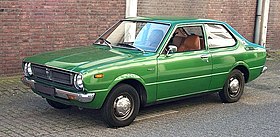| Toyota Corolla (E30/E50) | |
|---|---|
 | |
| Overview | |
| Model code | E30/E50 |
| Production | Aug 1974–July 1981[1] |
| Assembly | |
| Designer | Shirou Sasaki (1971) |
| Body and chassis | |
| Body style | |
| Layout | FR layout |
| Related | |
| Powertrain | |
| Engine | |
| Transmission | |
| Dimensions | |
| Wheelbase | 2,370 mm (93.3 in) |
| Length | 3,995 mm (157.3 in) |
| Width | 1,570 mm (61.8 in) |
| Height | 1,375–1,390 mm (54.1–54.7 in) |
| Curb weight | 785–955 kg (1,730.6–2,105.4 lb) |
| Chronology | |
| Predecessor | Corolla E20 |
| Successor | Corolla E70 |
The Corolla E30/E50 was the third generation of cars sold by Toyota under the Corolla nameplate. It was built from August 1974 to July 1981[1] and marked Toyota's greatest growth in the United States in the wake of the fuel crisis. In addition to its sister model, the Sprinter, there was a redesigned-body version built by Toyota affiliate Daihatsu, called the Daihatsu Charmant. While there were certain fourth-generation models with a longer model life, this generation, when considered as a whole, was the longest-lived one, possibly due to the worldwide recession in the 1970s. A large range of cars was built using this chassis, including Corollas, Sprinters, Daihatsu, and the sporty Levin and Trueno models with the DOHC motor, with a fuel injection upgrade added to Japanese Levin models in January 1977.[2]
Even though the E30 and E50 series were replaced by the E70 series in August 1979 in most markets, the original E30 series and the facelifted E50 series both continued to be produced until July 1981.[1]
- ^ a b c Toyota Vehicle Identification Manual. Japan: Toyota Motor Corporation - Overseas Parts Department. 1984. Catalog No.97913-84.
- ^ "Toyota Corolla". 75 Years of Toyota. Toyota Motor Corporation. Retrieved 11 June 2024.